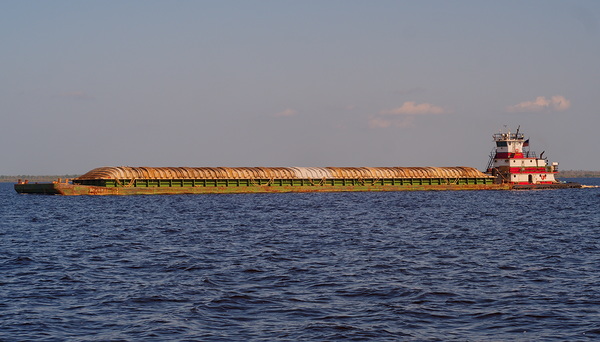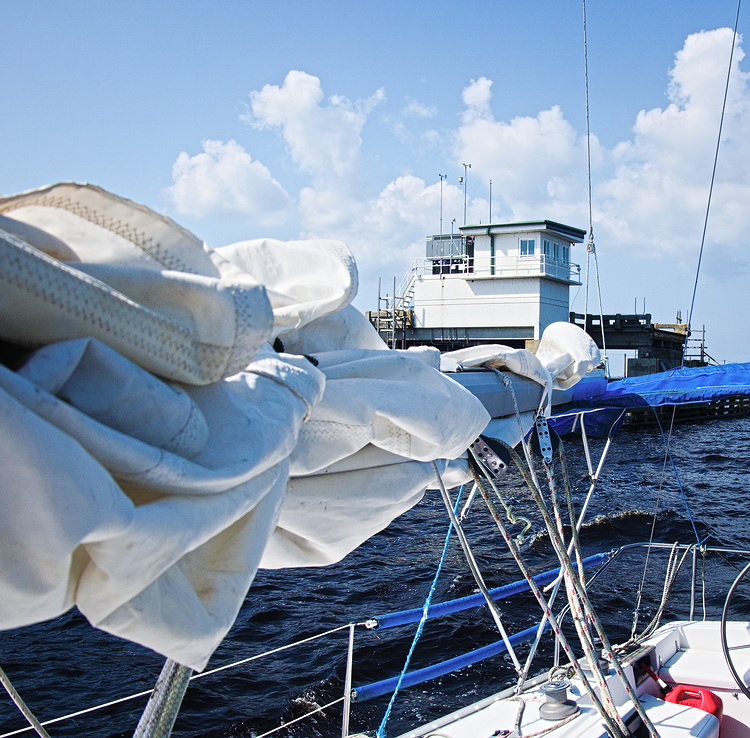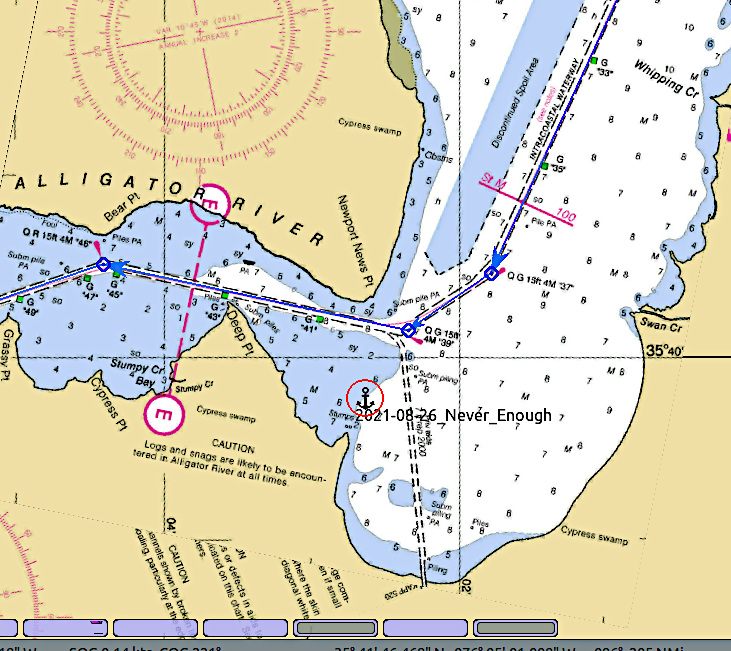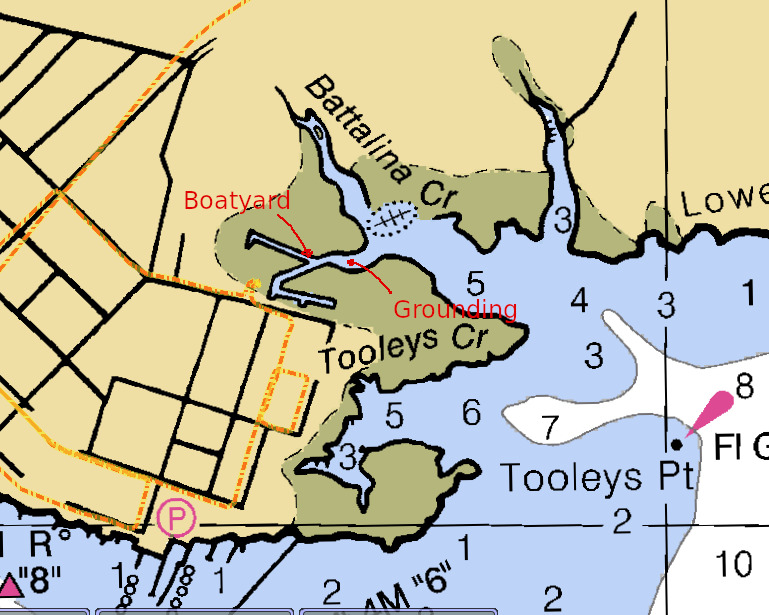To Belhaven
Text and Photographs by Paul Clayton
When Taylor went to the masthead> of his Hunter 31 Never Enough by way of bucket lift, he found more work than he could do on the spot. In fact, on consideration, he decided that it would be best to yard the boat and have the mast out. Last winter he had the boat at Mackey's, but he decided this time to give the new yard in Belhaven, TJ's, a try.
Taylor has crewed for me twice, and we get along, so when he asked me to crew for him to Belhaven I was amenable. This promised to be a motor haul, because the masthead jib halyard sheeve was damaged to the point that the jib couldn't be raised. We bent the main in case we got a slant that would allow us to sail under it alone, but figured we wouldn't use it. Never Enough sports a good Yanmar 2GM that should propel us the 82 miles to Belhaven.
We did a car shuttle Wednesday afternoon and got things ready for an Thursday morning departure. Belhaven is too far to try to do in a day, so we planned to anchor all the way up the Alligator River, just short of the entrance to the Canal. With the winds forecast as light out of the south to southwest, this would make a good place to overnight. Then we would have a short day into Belhaven on Friday.
We got off the dock at 7:30 Thursday morning and motored out into Edenton Bay. The light breeze helped temper the heat for the time, but still, the late August day promised to be a scorcher. Never Enough's bimini was going to be a lifesaver.
The Yanmar settled into a steady 2200 rpm beat, driving the boat eastward at around 5 1/2 knots. I was surprised at how smooth and quiet the little 2-cylinder was. We passed under the highway 32/37 bridge making good time.
Deep, heavy explosions could be heard from of military training facility on the Perquimans River. We favored the Bull Bay side of the sound, staying well away from the exclusionary zone to the north.
Abruptly, our attention was focused back on our own progress. The engine rpm dropped to 2000, though it continued to run smoothly. We both noticed it, and decided that perhaps we had picked up some trash on the keel or rudder. We came to a stop, put the boat in reverse and gunned it, hoping to throw off whatever had us fouled. Then we went back into forward and the engine picked up to 2200 and started pushing us down the sound.
We relaxed and I set out some snacks and ice water while Taylor manned the helm. But even though Taylor is usually a good feeder, he was feeling too anxious about the engine to eat, and with good reason. (Myself - years of experience with unreliable Atomic 4s and even less reliable outboards in the well of my Cape Dory have left me relatively indifferent to engine woes. I ate with a healthy appetite.) A few minutes later, the engine dropped back down to 2000.
This time we topped off the tank with fresh fuel and bled the water separator. The engine picked back up and ran smoothly at 2200 rpm.
In a couple of hours we were approaching the mouth of the Alligator River, preparing to follow the narrow zig-zag channel that would put us into the broad main body of the river. The engine dropped down to 2000, and even less. Taylor inspected all the fuel supply hoses and fittings, some of which didn't look too good, but didn't find an obvious leak. We decided to try to limp along until we could get on the anchor at the end of the day, then to change the fuel filter and carefully inspect the fuel system. For the time being, we bled the water separator again, and the engine picked up. We decided not to push our luck and to maintain no more than 2000 rpm at least until we got through the twisty shallow section.
 |
As we approached the bridge, Taylor deputized me to hail for an opening. I tried channels 16, 9 and 13, his radio and mine, and got no reply from the bridge master. We edged in closer to the bridge, and at last heard a cheery hail from the master, asking us if we needed an opening. I responded, "yes, please" and in a moment he had the gates down and the big span swinging into position. As we cleared, I thanked him and he wished us a pleasant day. Don't know what happened, maybe his radio was inadvertently switched off or he was taking a nap.
We proceeded up the river and in a few minutes the engine speed dropped off. Ahead we could see a barge tow coming our way so rather than shut down we decided to run at reduced rpm until we could get clear of the tow. Once we were clear, we shut down and Taylor once again climbed down into the cockpit locker and bled the separator. When he came back out, he said he felt a rush of air when he opened the bleeder.
I don't know much about engines but something told me the breather vent on the fuel tank might be clogged. I suggested we loosen the fill cap and leave it just hanging on a thread or two so that air could get into the tank. Taylor was willing to try anything so we did. After that, the engine ran smoothly all the way up the river to the anchorage.
The sun was getting low as we approached marker 39, where the river makes a hard jog to the west before entering the Canal. To the south of the marker there is enough water to anchor, protected by the shore from a light southwest wind like we had this evening. I have anchored in this area numerous times. The chart warns of stumps and piles but I have never had any problems. Once a stump or pile gets charted, it seems like it stays on the charts forever. Certainly nobody goes out there and periodically checks to see if the stump is still there.
Taylor went to the bow and got the anchor ready. I eased forward, straight into the wind, watching the depth. At eight feet, I called for Taylor to drop anchor as I took the boat out of gear. We drifted back until we had 50 feet of line out, then cleated off. After a few minutes, I eased the throttle in reverse, then applied more power to set the anchor. Once we were both satisfied that the boat was not moving, I shut down the power. The time was 7:30 pm, 12 hours since we left the dock on Pembroke Creek. That made an average speed of about 4.6 knots for the day, not bad for running on a gimpy engine. Looking back through my logs, I see that Phil and I aboard Oryoki ran from Edenton Marina to the Tuckahoe Point anchorage, just across the channel from where Taylor and I anchored, in 10 hours and 40 minutes, pushing hard with motor and sail.
It was a pleasure to soak up the quiet stillness, miles from the nearest house or road. But my enjoyment was interrupted by the acrid smell of scorched oil. I mentioned it to Taylor and went up on the bow, looking and sniffing for smoke. None was apparent, so it must be us. Below deck, Taylor flipped open the engine cover, and the source was clear. Heat waves rose off the oily engine. Taylor re-started it and let it idle a few minutes to cool down, which helped. Looking at the engine compartment, I was struck by how poorly ventilated it was, and we agreed that the following day we would leave the compartment lid open when possible to allow some cooler air inside. I've heard that Yanmars put up with abuse so I wasn't too worried.
Speaking of the engine installation, I noted with mild concern the gate valve on the through hull supplying cooling water to the engine. Taylor claims it isn't a gate valve - maybe not, but it's not a seacock. The exhaust exits through a hull right at water level which makes it difficult to tell how hard the exhaust is spitting. That made it feasible to avoid a riser in the exhaust, but it also makes it possible for a following sea to swamp the engine. In general, I'd say that to include lots of luxury features at a popular price, Hunter had to scrimp on some construction details.
I handled the cooking this trip and I must say, I outdid myself with dinner of hamburgers smothered in mushrooms and onions. This was accompanied by Sierra Nevada and Highland Brewing IPAs.
A spectacular starry sky came into view. The only lights visible were the anchor light of a trawler at Tuckahoe Bay, the green and red lights on the channel markers, and an occasional plane flying over. Other than that, not even a glow of a town on the horizon. The upper Alligator is one of the most remote places that a sailboat can reach.
I hung a light from the flag halyard since the masthead anchor light wasn't functioning. Taylor draped bug netting over all the open hatches and a light breeze flowing through made the boat comfortable.
I laid out on a narrow but comfortable settee in the saloon, while Taylor retired to the v-berth. In the morning, we both remarked on getting a good night's sleep. At about 7:00 I pulled up on the anchor while Taylor started the engine. The anchor broke free with just a little mud on the flukes, which I knocked off with a boathook as we motored out to the channel. In a half hour we entered the Alligator-Pungo Canal. The transit was routine. We passed just a few recreational northbounders, no barge tows. We saw a couple of eagles plus a few buzzards, hawks and gulls. We passed out into the Pungo River at about noon.
The well-marked channel curves to the south and then to the west. The river broadens and carries plenty of water, so from this point to Belhaven the markers are widely spaced. Taylor's chart plotter wiring had broken and my plotter was having intermittent issues finding a satelite, so he was getting anxious when we would pass a marker and not be able to visually pick up the next one. Experience with chart-reading as well as numerous trips down the Pungo River left me completely confident that as we continued our established course the next marker would soon come into view. And that is exactly what happened.
I had plotted a course to the mouth of Battalina Creek in advance. At Marker 13 we diverged to the WNW, and in a mile we were able to pick up the green marker at the mouth of the creek. TJ, the yard owner, had given us detailed instructions as to how to negotiate the creek, but he also warned that we would probably drag bottom and might get stuck. Since we both had Towboat U.S. cards, Taylor was willing to take the risk. The crew lives for adventure and is up for anything.
I was at the wheel as we passed Tooley's Creek Light 1, the only marker on the route into Battalina Creek. TJ had suggested staying well off the marker to starboard, and a finger of slightly deeper water was charted there. We followed it in as far as it went and then went aground. We were able to back off. A quick phone call to TJ elicited the suggestion that we try a few feet to port, where we found enough water to drag over the shoal. From here we proceeded up the mid-channel to near the sunken barge, visible by eye and by chart, where we turned into the final approach channel to the yard. Approximately 75 yards from the Travelift slip at TJ's, we started dragging bottom. We had been warned that the water would be shallow and we would probably have to plow through silt, so we continued our course. The water depth dropped, inch by inch, to 4 feet, where we ground to a halt.
Taylor was all for calling TowboatUS immediately, but I persuaded him to let me at least try to get off. After 15 minutes of trying, I had gotten the boat turned back out the channel, but still stuck fast. At that point we decided to call for a tow, and keep trying to get free until it arrived. I had visions of a long wait, as the TowboatUS franchise is held by the River Forest yard immediately adjacent to TJ's, and I had heard just enough innuendo to guess that there was bad blood between the two facilities. But the tow arrived quickly. Taylor asked the towboat captain if he had done a lot of tows off this shoal, and he replied sarcastically. "Oh, 330 over the past year, or maybe its 329". He suggested that to his knowledge no boat had ever gotten in to TJ's without a tow. Of course, River Forest shares the same channel, so evidently that goes for them too. It occured to me that the TowboatUS franchise has a symbiotic relationship with the yard, picking up lots of easy, quick tows all covered by the insurer at standard rates.
The towboat drug us right to the Travelift dock, where we tied off with the help of a yard staffer and a friendly sailor working on his own boat. I brought the car around to the dock, and we transloaded a big pile of stuff to the trunk and back seat. Then we removed the mainsail, folded it and stowed it below deck, just because we like laboring in the hot sun.
I had cadged the shower combination off somebody, so I left Taylor drinking a beer while I got cleaned up. Then I sat in a rocker on the porch and had a beer while Taylor cleaned up. That left us in decent shape for the drive back to Edenton.
TJ informs us that he has permits in hand to dredge the entrance channel this November, and he is working with the Coast Guard to get the channel marked. If these projects are achieved, it will go a long way toward giving Albemarle Sound sailors a good yard a lot closer than Oriental. As Taylor completes the work on Never Enough, expect to see reports here as to how things go.
Never Enough proved to be a comfortable, easily-handled boat. She needs a refit, but so do most of the boats in the marina. The design and construction preclude any kind of heavy weather sailing, but for mild, sunny summer days she's just the ticket. I look forward to crewing aboard her again.
Text and Photographs by Paul Clayton. Posted 09/11/21.
Copyright © 2021 Paul M. Clayton


